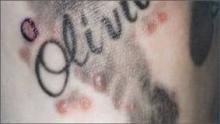Tattoo ink contaminated with Mycobacterium chelonae caused skin infections in 19 people in one New York county last year, underscoring the need for regulatory oversight of tattooing and the inks used in tattooing to ensure public safety.
"Since tattooing has become more popular over time, the incidence of cutaneous mycobacterial infections may be underestimated, given the lack of both routine testing and mandated reporting," wrote Dr. Byron Kennedy and his colleagues. And, "although contamination in tattoo parlors has been implicated in previous outbreaks, our investigation of this outbreak shows that premixed ink contaminated before distribution poses a risk to public health," they reported Aug. 22 in the New England Journal of Medicine (2012 [doi: 10.1056/NEJMoa1205114]).
Investigators at the Monroe County (N.Y.) Department of Public Health tracked the infections to a specific tattoo parlor – and even to a single tattoo artist using a new brand of premixed ink.
The Centers for Disease Control and Prevention (CDC) found the contaminated ink in an investigation that eventually led to a voluntary withdrawal of the product, the investigators noted.
In January, public health officers received a report of a male patient with a persistent granulomatous rash on a recently tattooed area of his arm, wrote Dr. Kennedy, deputy director of the Monroe County public health department, and his colleagues. The patient had received a number of tattoos in his town of Rochester, and had never experienced any reaction. His primary care physician had unsuccessfully treated him with glucocorticoids, so he was referred to a dermatologist. Histopathology showed infection with M. chelonae.
Health department investigators found similar reactions in patients who received tattoos from the same artist at the parlor. During May-December 2011, the artist had been using a new brand of premixed, hand-blended, diluted gray ink as a wash to produce shadow effects. The product contained pigment, distilled water, witch hazel, and glycerin. It was packaged in 20%, 60%, and 90% dilutions.
The artist provided a list of clients who had received tattoos during the time the suspect ink was in use.
Investigators contacted all tattoo parlors in the county to inquire about the type of ink used, and to find out if any clients reported adverse events. No other parlors reported using the ink, and none had received reports of rashes from either patrons or local health care workers.
The tattoo parlor and artist associated with the infection appeared to follow best-practice techniques by using sterile needles, disposable gloves, and ink poured into single-use containers, as well as by providing after-care instructions. The artist did not dilute any inks at the parlor, and there appeared to be no contamination from tap water.
The Food and Drug Administration inspected the facility that manufactured and distributed the premixed ink, and collected packaging materials and samples of the ink and its ingredients. The samples were sent to the CDC for culture.
The investigation identified 19 subjects who developed a similar erythematous rash after receiving tattoos from the same artist at the same location. Clinical results were available for 17. Twelve showed sparse lymphohistiocytic infiltrates in the upper dermis. Granulomas were present in five and acid-fast bacteria in two of the patients. DNA sequencing identified M. chelonae as the causative agent. The organism was also found in an unopened bottle of the 30% dilution ink.
Antibiotic sensitivity testing was performed on two samples. The first culture showed sensitivity to clarithromycin, doxycycline, and linezolid; had intermediate resistance to ciprofloxacin; and was resistant to cefoxitin. The second culture was sensitive to clarithromycin and doxycycline, had intermediate resistance to linezolid, and was resistant to ciprofloxacin and cefoxitin. Most (18) of the patients received effective treatment and improved.
The investigators collected the rest of the premixed ink from the tattoo parlor, and the CDC issued a national alert about the outbreak with the intent of discovering additional cases.
Three states – Washington, Iowa, and Colorado – reported clusters of cutaneous M. chelonae infections associated with tattoos, the CDC noted Aug. 22 in a companion article published in Morbidity and Mortality Weekly Report.
Two clusters occurred in Washington, Brenden Bedard of the Monroe County public health department and his colleagues wrote in MMWR. Cluster 1 included three confirmed and 24 possible cases, all in people tattooed with ink from the same company. Samples from the ink company did not grow the organism, but the company reported that it had received complaints of long-lasting skin reactions.


